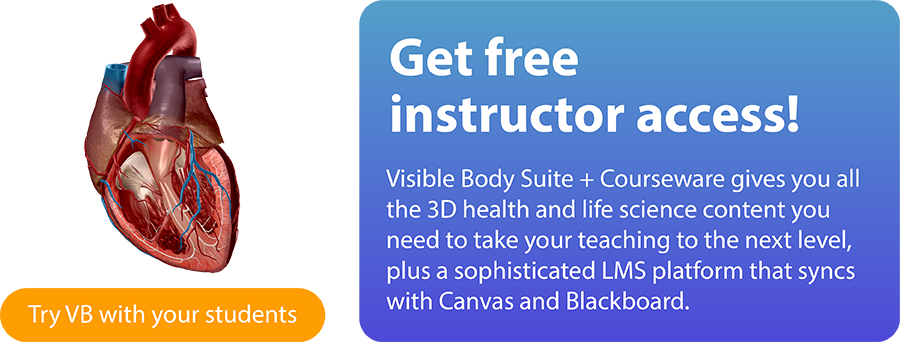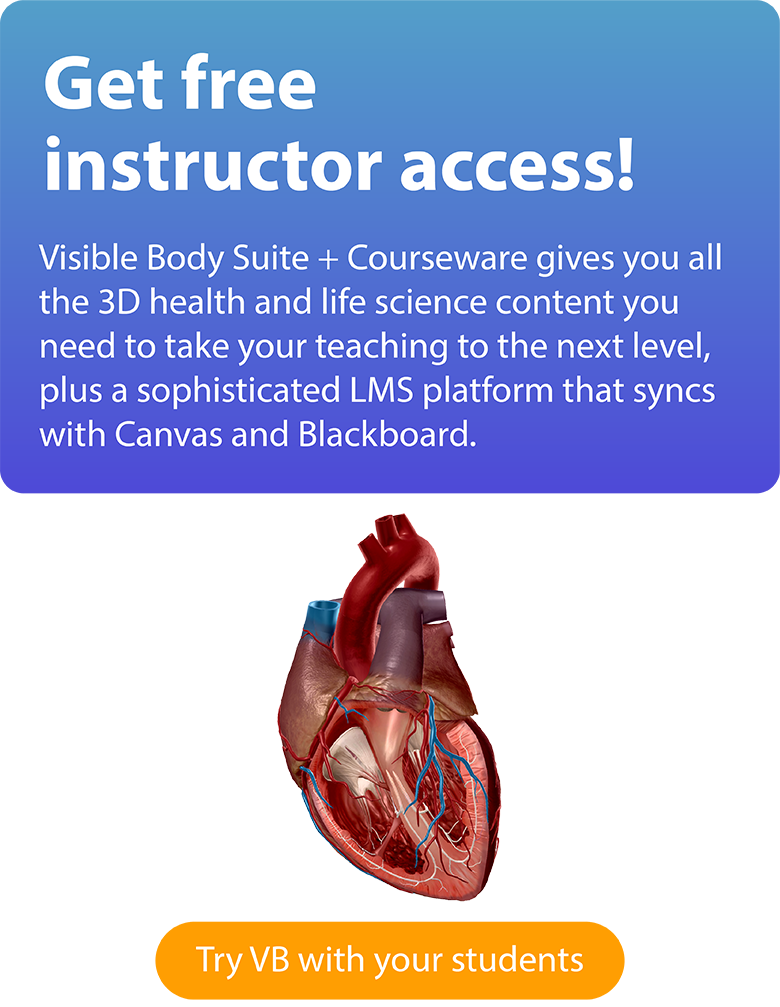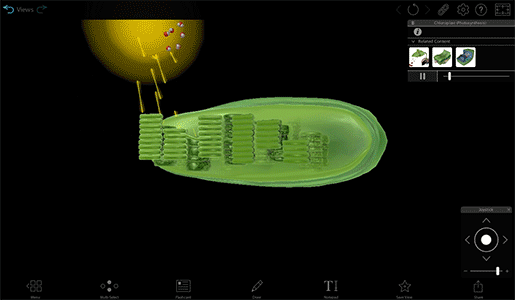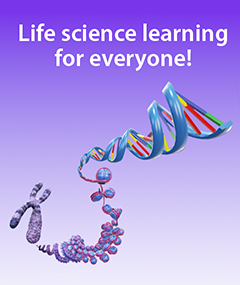Active Learning Lesson Plan: Photosynthesis and Cellular Respiration with Visible Body Suite
Posted on 2/7/25 by Sarah Boudreau
Many students learn photosynthesis and cellular respiration through rote memorization, and all that information disappears once they take the test—but through active learning, students can gain a deeper understanding of these crucial processes.
In this blog post, we’ll take you through a webinar on teaching photosynthesis and cellular respiration with Visible Body Suite, delivered by Dr. Cindy Harley of Metropolitan State University. Cindy uses her years of teaching experience and a knack for breaking down complex concepts to give instructors lots of practical ideas for the classroom.
Cindy's photosynthesis and cellular respiration lesson plan covers:
- The basics of photosynthesis and cellular respiration
- Activities that encourage collaboration
- Discussion prompts
- Skills students can transfer to their future careers


Start with photosynthesis
Cindy suggests starting with photosynthesis. It’s easy to access the photosynthesis model in VB Suite—from the main menu, select Biology and scroll to the Energy unit. Alternatively, you can use the Search function to find exactly what you want.
 Photosynthesis model in VB Suite.
Photosynthesis model in VB Suite.
Start with a “zoomed out” view, focusing on the leaf at the top of the model. Your students can observe the light hitting the leaf, and the CO₂ and water entering. You can pause, rewind, or skip ahead in the animation to walk students through the process. As you look at different parts of the model, ask your students to explain what is being represented on the screen. This way of understanding photosynthesis taps into the visual style of learning that many students prefer.
Cindy loves doing card sorting activities with her students, using notecards or printouts. In addition to multiple cards that say “In” and “Out,” she suggests using cards that say:
- CO₂
- O₂
- H₂O
- Glucose
- Sunlight
Break students up into groups and give each group a set of cards. Each group will then sort the cards into the correct order of inputs and outputs, using the photosynthesis model as a guide. For an extra layer of complexity, you can go deeper and ask how many CO₂, H₂O, O₂, and glucose molecules are involved in each step.
Examine the chloroplast
In this section, take a closer look at the Plant Cell model. Using the Dissect tool, dissect the chloroplast to see the structures within it.
At this point, Cindy suggests that you have your students take screenshots and label each of the structures they see. In addition to helping them learn the structure of the cell, this activity encourages digital literacy.
Cindy uses an activity she calls, “America’s Next Top Cell,” to get students thinking critically about plant and animal cells. In this activity, students debate which of the cells is better at creating energy. This results in a deeper understanding of the differences between the cells—and some very creative banter!
 Chloroplast (Photosynthesis) model in VB Suite.
Chloroplast (Photosynthesis) model in VB Suite.
Next, have your students look at the Chloroplast (Photosynthesis) model. Observe the inputs and outputs represented in the model and ask your students discussion questions to get them actively engaged:
- What’s happening right now?
- What is going where?
- What is that?
- Which molecules are involved?
- What do you think the equation is?
You can then explore the photosynthetic pathway and electron transport chain. Once students understand the inputs and outputs, it’s time to take a closer look at the processes at play.
Light and dark reactions
To teach the light dependent and light independent reactions of photosynthesis, Cindy uses a jigsaw activity, where students are put into two groups: Team Light Reaction and Team Dark Reaction. Each group studies its reaction and then teaches its reaction to the other group. This activity encourages peer interaction for a more active classroom environment. Through teamwork, struggling students can receive guidance from their peers, and students with a better grasp of the content can strengthen their understanding by articulating concepts in new ways—another transferable skill.
 Light dependent reaction. Chloroplast (Photosynthesis) model in VB Suite.
Light dependent reaction. Chloroplast (Photosynthesis) model in VB Suite.
Cindy often uses labeling activities in her classroom. The annotation tools in VB Suite make it easy to take notes and illustrate your points by drawing in 3D. Users can add circles, other basic shapes, and freehand drawings in several different colors and opacities, while the tagging and Notepad features make adding text a breeze. You can ask your students to walk through the light dependent reactions, using annotation tools as they label proteins, indicate gradients, summarize what’s happening, and discuss the molecules involved.
To understand the light independent reactions, Cindy recommends asking students to pause the interactive animation, breaking it into these three parts: fixation, reduction, and regeneration.
Photosynthesis lab
At this point, students are ready for a photosynthesis lab! Visible Body provides a library of premade lab activities, including one on photosynthesis.
In this lab activity, students begin by working through labeling exercises that ensure they have a solid knowledge foundation. Then, they get hands on with an activity that uses pieces of spinach leaves submerged in water to show photosynthesis in action.
These disks would typically float in water because the leaves have air-filled spaces between their cells. By filling those spaces with liquid, you can cause them to sink. In this lab, you and your students will expose the leaf disks to a bicarbonate solution and expose them to light to initiate photosynthesis, which will convert carbon dioxide and water into glucose and oxygen. The oxygen causes the leaf disks to float again.
Visible Body's premade lab activities are in Word format, making it easy for instructors to modify them to suit their classrooms. Cindy takes the lab activity a step further by adding theater gels, the filters used in theaters to change the color of the lights. The gels block out parts of the light spectrum. Cindy asks her students to hypothesize which parts of the spectrum are most important for photosynthesis.
Cellular respiration
Cindy suggests explicitly making the connection between cellular respiration and breathing—students often don’t make the connection between the two forms of respiration! Connecting cellular respiration to “real life” applications like physiology is an effective way to engage students.
When teaching cellular respiration, Cindy gives her students guided notes to work through, including a chart that breaks down the basic inputs and outputs for each step: glycolysis, the oxidation of pyruvate, the citric acid cycle, and the electron transport chain.
Using the Mitochondrion (Cellular Respiration) model in VB Suite, ask students to connect what they see in the animation with what they know about cellular respiration. Have students explain which parts of the model are showing which steps.
 Mitochondrion (Cell Respiration) model in VB Suite.
Mitochondrion (Cell Respiration) model in VB Suite.
In regards to the electron transport chain part of cellular respiration, ask students to compare the process to what they’ve already learned in the photosynthesis model. What do they think the electron transport chain would look like in a mitochondrion?
Students can work through the cellular respiration premade lab activity, which walks them through the models and breaks down the process step by step. Cindy suggests having students complete the lab activity at home and come into the classroom ready to discuss the content as part of a flipped classroom model.
Assignment ideas
Cindy closed out the webinar by talking about assignments and other ideas for teaching cellular respiration and photosynthesis. Cindy likes to give her students creative assignments that challenge them to think critically about the information.
“It's about them thinking about the material and what it would look like instead of just regurgitating what they've memorized,” she explained.
Her students use VB Suite and screen capturing to create short, five-minute lessons walking the viewer through the process, and she also has her students create comic books or informational pamphlets that illustrate these processes. Cindy gave an entire webinar about these alternative forms of assessment—check out this blog recap for a more in-depth explanation and ideas for grading rubrics!
Cindy also gave a couple discussion ideas that will help students make further connections:
- Mitochondrial disorders in humans (like mitochondrial DNA depletion syndrome)
- Leaf sheep: Costasiella kuroshimae is a sea slug that indirectly performs photosynthesis, thanks to a symbiotic relationship with a photosynthetic bacterium
- Forcing rhubarb, a technique for growing rhubarb that keeps the plant in almost complete darkness
The team at Visible Body would like to thank Dr. Cindy Harley, once again, for delivering a great webinar and sharing her fantastic ideas!
NGSS Standards
The above lesson plan fits these Next Generation Science Standards (NGSS):
HS-LS1 From Molecules to Organisms: Structures and Processes. Students who demonstrate understanding can:
- Develop and use a model to illustrate the hierarchical organization of interacting systems that provide specific functions within multicellular organisms. (HS-LS1-2)
- Use a model to illustrate how photosynthesis transforms light energy into stored chemical energy. (HS-LS1-5)
- Use a model to illustrate that cellular respiration is a chemical process whereby the bonds of food molecules and oxygen molecules are broken and the bonds in new compounds are formed resulting in a net transfer of energy. (HS-LS1-7)
HS-LS2 Ecosystems: Interactions, Energy, and Dynamics. Students who demonstrate understanding can:
- Develop a model to illustrate the role of photosynthesis and cellular respiration in the cycling of carbon among the biosphere, atmosphere, hydrosphere, and geosphere. (HS-LS2-5)
- Construct and revise an explanation based on evidence for the cycling of matter and flow of energy in aerobic and anaerobic conditions. (HS-LS2-3)
- Develop a model to illustrate the role of photosynthesis and cellular respiration in the cycling of carbon among the biosphere, atmosphere, hydrosphere, and geosphere. (HS-LS2-5)
Be sure to subscribe to the Visible Body Blog for more anatomy awesomeness!
Are you an instructor? We have award-winning 3D products and resources for your anatomy and physiology course! Learn more here.



